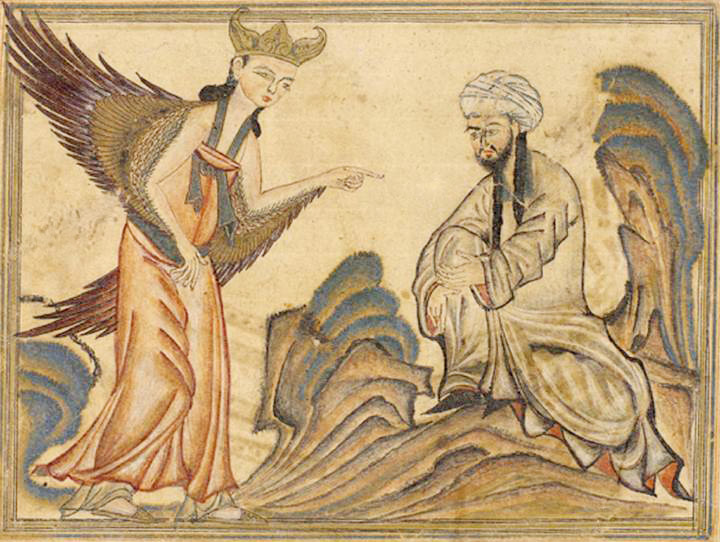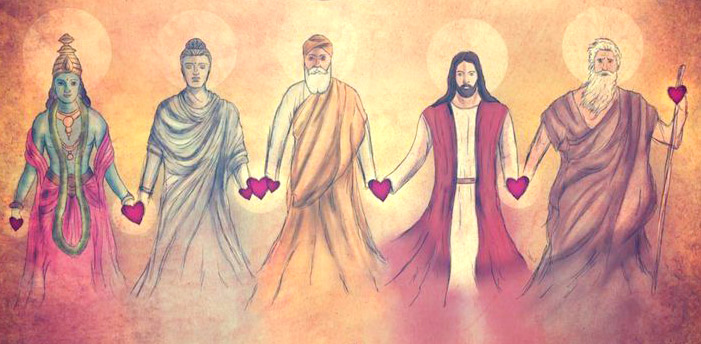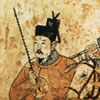Understanding Mohammed
 UN.AR.I.U.S. understands that religion is a necessary step in a person’s evolution but at some point in order to continue progress into the spiritual realms one must integrate oneself with the actual functioning creative mechanics of Infinite Intelligence by understanding and putting into action these principles. One cannot achieve this without learning how Infinity or our current reality operates (or works) and our place in it. At some point in our evolution the paganistic aspects of religion are discarded supplanted by a working model that allows us to be a integrated functioning element of Infinity and in doing so achieve that long sought after immortality. UN.AR.I.U.S. shares and teaches these principles as a starting point in a person’s spiritual evolution.
UN.AR.I.U.S. understands that religion is a necessary step in a person’s evolution but at some point in order to continue progress into the spiritual realms one must integrate oneself with the actual functioning creative mechanics of Infinite Intelligence by understanding and putting into action these principles. One cannot achieve this without learning how Infinity or our current reality operates (or works) and our place in it. At some point in our evolution the paganistic aspects of religion are discarded supplanted by a working model that allows us to be a integrated functioning element of Infinity and in doing so achieve that long sought after immortality. UN.AR.I.U.S. shares and teaches these principles as a starting point in a person’s spiritual evolution.
 Like prior advance spiritual personages who have visited earth from time to time, Mohammed too came to the earth plane to provide needed spiritual direction to the masses at that time just as Jesus, Buddha, Krishna and many more known and unknown throughout the world’s history.
Like prior advance spiritual personages who have visited earth from time to time, Mohammed too came to the earth plane to provide needed spiritual direction to the masses at that time just as Jesus, Buddha, Krishna and many more known and unknown throughout the world’s history.
Biography – Muhammad is the founder of the religion of Islam, seen by Muslims as the last of the prophets of God. Source: Bibliotheca Alexandrina-Compiled by Neveen Nagy
Early Life
Muhammad (Peace be upon him), in full Abu al-Qasim Muhammad ibn ‘Abd Allah ibn ‘Abd al-Muttalib ibn Hashim, was born 570 in Mecca, Arabia [now in Saudi Arabia]. His father, ‘Abd Allah, and his mother, Aminah, belonged to the family of the Banu Hashim, a branch of the powerful Quraysh, the ruling tribe of Mecca, that also guarded its most sacred shrine, the Ka’bah. ‘Abd Allah died before Muhammad’s birth; without a father, Muhammad experienced many hardships, even though his grandfather ‘Abd al-Muttalib was a leader in the Meccan community.
In order for Muhammad to master Arabic in its pure form and become well acquainted with Arab traditions, Aminah sent him as a baby into the desert, as was the custom of all great Arab families at that time. Aminah chose a poor woman named Halimah from the tribe of Banu Sa’d, a branch of the Hawazin, to suckle and nurture her son. And so the young Muhammad spent several years in the desert. It was also at this time that, two angels appeared to Muhammad in the guise of men, opened his breast, and purified his heart with snow. Amazed by this event and also noticing a mole on Muhammad’s back (later identified in the traditional sources as the sign of prophecy), Halimah and her husband, Harith, took the boy back to Mecca.
Muhammad’s mother died when he was six years old. Now completely orphaned, he was brought up by his grandfather ‘Abd al-Muttalib, who also died two years later. He was then placed in the care of Abu Talib, Muhammad’s uncle and the father of ‘Ali, Muhammad’s cousin. Later in life Muhammad would repay this kindness by taking ‘Ali into his household and giving his daughter Fatimah to him in marriage.
It is believed that Muhammad grew into a young man of unusual physical beauty as well as generosity of character. His sense of fairness and justice were so revered that the people of Mecca often went to him for arbitration and knew him as al-Amin, “the Trusted One.” His striking appearance is the subject of countless poems in various languages.
When he was 25 years old, Muhammad received a marriage proposal from a wealthy Meccan woman, Khadijah bint al-Khuwaylid, whose affairs he was conducting. Despite the fact that she was 15 years older than he, Muhammad accepted the proposal, and he did not take another wife until after her death (though polygyny was permitted and common). She bore him two sons, both of whom died young. It is from the first son, Qasim, that one of the names of the Prophet, Abu al-Qasim (“the Father of Qasim”), derives. She also bore him four daughters, Zaynab, Ruqayyah, Umm Kulthum, and Fatimah.
By age 35, Muhammad had become a very respected figure in Mecca and had taken ‘Ali into his household. When he was asked, according to Islamic tradition, to arbitrate a dispute concerning which tribe should place the holy black stone in the corner of the newly built Ka’bah, Muhammad resolved the conflict by putting his cloak on the ground with the stone in the middle and having a representative of each tribe lift a corner of it until the stone reached the appropriate height to be set in the wall.
His reputation stemmed, in part, from his deep religiosity and attention to prayer. He often would leave the city and retire to the desert for prayer and meditation. Moreover, before the advent of his prophecy, he received visions that he described as being like “the breaking of the light of dawn.” It was during one of these periods of retreat, when he was 40 years old and meditating in a cave called Hira’ in the Mountain of Light (Jabal al-Nur) near Mecca, that Muhammad experienced the presence of the archangel Gabriel and the process of the Quranic revelation began.
The Meccan Period
Muhammad (PBUH) first preached his message to the members of his family, then to a few friends, and finally, three years after the advent of the revelation, to the public at large. The first to accept Muhammad’s call to become Muslims were Khadijah; ‘Ali; Zayd ibn al-Harith, who was like a son to the Prophet; and Abu Bakr, a venerable member of the Meccan community who was a close friend of the Prophet. Besides his family and friends, a number of prominent Meccans embraced Islam.
However, most influential figures and families rejected his call, especially those prominent in trade. These naysayers feared that the new religion, based on the oneness of God and unequivocally opposed to idolatry, would destroy the favoured position of the Ka’bah as the centre of the religious cults of various Arab tribes and hence jeopardize the commerce that accompanied the pilgrimage to Mecca to worship idols kept in or on the Ka’bah. As Muhammad’s message spread, opposition to him grew and was led by ‘Amr ibn Hisham, dubbed Abu Jahl (“Father of Ignorance”) by the early Muslims. Abu Jahl even had some early converts tortured, which resulted in the death of one of them named Summayyah. Muhammad himself, unharmed because of the protection of his family and especially his uncle Abu Talib, then gave permission to a number of early disciples to migrate temporarily to Abyssinia, where the country’s monarch, the negus, received them with kindness and generosity.
In 619, Muhammad (PBUH) was greatly saddened by the death of two people who were especially close to him, Khadijah and his uncle Abu Talib. The death of Abu Talib, Muhammad’s protector, created a much more difficult situation for him and for the young Islamic community in Mecca. These deaths, combined with Muhammad’s lack of success in propagating the message of Islam in the city of Ta’if, severely tested his determination and resolve.
During this extremely difficult time Muhammad (PBUH) underwent the supreme spiritual experience of his life. On one of his nightly visits to the Ka’bah, he fell asleep in the Hijr, an uncovered sanctuary attached to the north wall of the Ka’bah, and experienced the Nocturnal Ascent (Isra’ or Mi’raj): Muhammad (PBUH) was taken by the archangel Gabriel on the winged steed Buraq to Jerusalem. From the rock upon which Abraham offered to sacrifice his son (now the site of the Dome of the Rock), they ascended through all the higher states of being to the Divine Presence itself.
Muhammad (PBUH) is said to have received the supreme treasury of knowledge while he stood and then prostrated himself before the divine throne. God also revealed to him the final form and number of the Islamic daily prayers.
In or around 621, a delegation from Yathrib, a city north of Mecca, contacted Muhammad (PBUH) and, having heard of his sense of justice and power of leadership, invited him to go to their city and become their leader. At that time, Yathrib suffered from constant struggle between its two leading tribes, the ‘Aws and the Khazraj, with a sizable Jewish community constituting the third important social group of the city. Finally, Muhammad (PBUH) departed with Abu Bakr for Yathrib. On September 25, 622, he completed the Hijrah (“migration”; Latin: Hegira) and reached Yathrib, which became known as Madinat al-Nabi (“City of the Prophet”), or Medina. This momentous event led to the establishment of Islam as a religious and social order and became the starting point for the Islamic calendar.
The Medinan Period
When Muhammad (PBUH) first settled in Medina, his most trusted followers were those who had migrated from Mecca—some before him and some, including ‘Ali, shortly after. Soon, however, many Medinans embraced Islam, so the early Islamic community came to consist of the emigrants (al-muhajirun) and the Medinan helpers (al-ansar). Muhammad (PBUH) integrated the Medinan community—the muhajirun and the ansar and the Muhammad Aws and Khazraj tribes—into an Islamic society, the enmity between Medina’s Jewish community and the newly founded Islamic order grew.
During the second year of the Hijrah, Muhammad (PBUH) drew up the Constitution of Medina, defining relations between the various groups in the first Islamic community. That same year the direction of daily prayers, or the qiblah, was changed by divine order from Jerusalem to Mecca, which marked the clear crystallization of Islam as a distinct monotheistic religion.
The Early Battles
The enmity between the Quraysh and Muhammad remained very strong, in part because of the persecution, aggression, and confiscation of property the Muslims suffered at the hands of the Quraysh. On several occasions warriors from Medina intercepted caravans from Mecca going to or coming from Syria, but Muhammad (PBUH) did not want to fight a battle against the Meccans until they marched against the nascent Medinan community and threatened the very future of Islam.
In 624, an army of 1,000 assembled by the Quraysh marched against Medina and met a much smaller force of 313 Muslims at a place called Badr on the 17th day of the month of Ramadan. Although heavily outnumbered, the Muslims achieved a remarkable victory in which, however, nine of the Companions of the Prophet (al-sahabah), the close associates of Muhammad (PBUH) and the faithful who were associated directly with him, were killed.
The Quraysh, however, did not give up their quest to destroy the nascent Islamic community. With that goal in mind, in 624–625 they dispatched an army of 3,000 men under the leader of Mecca, Abu Sufyan. Muhammad (PBUH) led his forces to the side of a mountain near Medina called Uhud, and battle ensued. The Muslims had some success early in the engagement, but Khalid ibn al-Walid, a leading Meccan general and later one of the outstanding military figures of early Islamic history, charged Muhammad’s left flank after the Muslims on guard deserted their posts to join in the looting of the Quraysh camp. Many of Muhammad’s followers then fled, thinking that the Prophet had fallen. In fact, although wounded, he was led to safety through a ravine. Meanwhile, the Quraysh did not pursue their victory. A number of eminent Muslims, including Muhammad’s valiant uncle Hamzah, however, lost their lives in the struggle. The Jews of Medina, who allegedly plotted with the Quraysh, rejoiced in Muhammad’s defeat, and one of their tribes, the Banu Nadir, was therefore seized and banished by Muhammad (PBUH) to Khaybar.
The Jews of Medina then urged the Quraysh to take over Medina in 626–627. To this end, the Quraysh helped raise an army of 10,000 men, which marched on Medina. Salman al-Farsi, the first Persian convert to Islam whom Muhammad (PBUH) had adopted as a member of his household, suggested that the Muslims dig a ditch around the city to protect it, a technique known to the Persians but not to the Arabs at that time. The Meccan army arrived and, unable to cross the ditch, laid siege to the city but without success. The invading army gradually began to disperse, leaving the Muslims victorious in the Battle of the Ditch (al-Khandaq).When it was discovered that members of the Jewish tribe Qurayzah had been complicit with the enemy during the Battle of the Ditch, Muhammad (PBUH) turned against them. The Qurayzah men were separated from the tribe’s women and children and ordered by the Muslim general Sa’d ibn Mu’adh to be put to death; the women and children were to be enslaved.
The Islamic community had become more solidly established by 628, and in that year Muhammad (PBUH) decided to make the ‘umrah (“lesser pilgrimage”) to the Ka’bah. He set out for Mecca with a large entourage and many animals meant for sacrifice, but an armed Meccan contingent blocked his way. Because he had intended to perform a religious rite, he did not want to battle the Meccans at that time. So he camped at a site known as Al-Hudaybiyah and sent ‘Uthman to Mecca to negotiate a peaceful visit. When ‘Uthman was delayed, Muhammad (PBUH) assembled his followers and had them make a pact of allegiance (al-bay’ah) to follow him under all conditions unto death. ‘Uthman finally returned with Quraysh leaders who proposed as a compromise that Muhammad return to Medina but make a peaceful pilgrimage to Mecca the next year. In addition, a 10-year truce was signed with the Meccans.
In 628–629, Muhammad’s first conquest was made when the Muslims captured Khaybar in a battle in which the valour of ‘Ali played an important role. The Jews and Christians of Khaybar were allowed to live in peace, protected by the Muslims, but they were required to pay a religious tax called the jizyah. This became the model for the later treatment of People of the Book in Islamic history.
It was also at this time that Muhammad (PBUH), according to Islamic sources, sent letters inviting various leaders to embrace Islam, including the muqawqis, the governor of Alexandria; the negus of Abyssinia; Heraclius, the emperor of Byzantium; and Khosrow II, the king of Persia. He emphasized in these letters that there should be no compulsion for People of the Book—Jews, Christians, or Zoroastrians—to embrace Islam.
In 628–629, Muhammad (PBUH) finally made a pilgrimage to Mecca and reconciled members of his family and also of many of his followers. It was also during this pilgrimage that a number of eminent Meccans—including two later major military and political figures, Khalid ibn Walid and ‘Amr ibn al-‘As—embraced Islam. Meanwhile, Islam continued to spread throughout Arabia, although military expeditions to the north were not successful.
In 628–629 the Quraysh broke the pact agreed upon at Al-Hudaybiyah, freeing Muhammad (PBUH) to march on Mecca, which he did with a large group of the ansar, the muhajirun, and Bedouins. The Quraysh pleaded for amnesty, which was granted. Muhammad (PBUH) went directly to the Ka’bah, where he ordered ‘Ali and Bilal, the Abyssinian caller to prayer (al-mu’adhin), to remove all the idols and restore the original purity of the Ka’bah, which Muslims believe was built by Abraham as the house of the one God. All the Meccans then embraced Islam.
Islamization of Arabia
In 630–631 embassies from all over the Arabian Peninsula arrived in Medina to accept Islam, and by that time most of Arabia, save for the north, had united under the religion’s banner. Muhammad (PBUH), therefore, marched with a large army north to Tabuk but did not engage the enemy. Nevertheless, the Jews and Christians of the region submitted to his authority, whereupon Muhammad (PBUH) again guaranteed their personal safety and freedom to practice their religion as he did for the Zoroastrians of eastern Arabia. At that time too, the pagan Arab tribes in the north, as well as in other regions, embraced Islam.
Finally, in 632, Muhammad (PBUH) made the first Islamic pilgrimage to Mecca (al-hajj), which remains the model to this day for the millions of Muslims who make the hajj each year. At that time he delivered his celebrated farewell sermon, and the last verse of the Qur’an was revealed. On the way back from Mecca, he and his entourage stopped at a pond called Ghadir Khumm where, according to both Sunni and Shiite sources, he appointed Ali as the executor of his last will and as his wali, a term that means “friend” or “saint” and also describes a person who possesses authority.
Death
Late in the spring of 632, Muhammad (PBUH), who had been considering another expedition to the north, suddenly fell ill and, according to tradition, died three days later on June 8, 632. According to Islamic norms that he established, his body was washed by his family, especially by ‘Ali, and buried in his house adjacent to the mosque of Medina. His tomb remains the holiest place in Islam after the Ka’bah; it is visited by millions of pilgrims annually.
Mohammed’s Successors by Washington Irving
How Islam Assisted With the Progression of Scientific Thought Through The Early Centuries:
Posted in Other Topicswith comments disabled.





